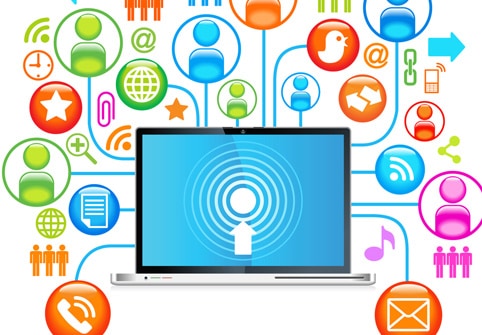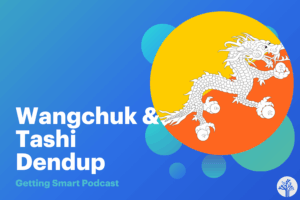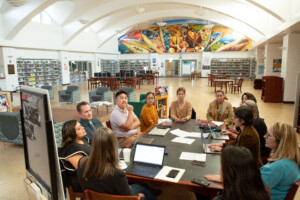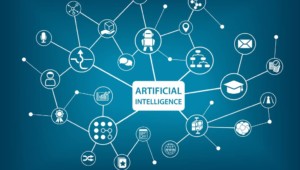New Horizon Report Insists Teachers Use Tech

The NMC Horizon Report: 2014 K-12 Edition was released this past week, examining emerging technologies and their potential impact on teaching and learning worldwide. Part of the NMC Horizon Project, a 12-year effort, this report highlights “six trends, challenges, and emerging technologies that will affect current practice” over the next five years. Aside from being great content for your next Twitter chat, this year’s iteration of the NMC Horizon Report is a must-read for 21st century educators and education policy makers alike. Following is a summary of major points.
Emerging Trends
Rethinking the Roles of Teachers: 21st century demands create an imperative on teachers to make the shift from being a “sage on the stage” to a “guide on the side”; something akin to a partner in learning. The Horizon Report says that, “In ideal situations, the teacher’s role is becoming that of a mentor, visiting with groups and individual learners during class to help guide them, while allowing them to have more of a say in their own learning.” In order to provide for such a paradigm shift, however, the report insists that ample opportunities for professional development be provided to educators, citing the current practice in Singapore of empowering every teacher with 100 hours of training per year.
A Shift to Deeper Learning Approaches: The goal of deeper learning experiences is for students to learn by doing and to develop a sense of self-efficacy as students. This can be achieved through “self-directed projects where students think critically and communicate effectively . . . mastering core academic content aligned with 21st century skills while tackling real issues in their community and beyond.” Understanding the significant role that technology plays in deeper learning approaches, educational leaders such as The Alliance for Excellent Education, the Buck Institute for Education, and the Hewlett Foundation are working together to “develop more professional development opportunities for teachers so they can integrate deeper learning in the classroom.”
Increasing Focus on Open Educational Resources (OER): Referring to intellectual property issues regarding the production of teaching and learning materials online, the Horizon Report identifies open textbooks for K-12 schools as having become a viable response to both the rising costs of traditionally published materials along with the lack of education resources in some regions. Currently, however, there are only eight states in the U.S. with policies that “support the creation and dissemination of OER in school districts, according to iNACOL. In their 2013 OER State Policy in K-12 Education report, the online learning association cites two main barriers to OER development for schools in the U.S. The first is “lack of funding and oversight to support initiatives.” And the second is “[the] subsequent lack of resources for marketing and promoting OER.”
Increasing Use of Hybrid Learning Designs: Providing the best of online learning and traditional classroom instruction, the Horizon Report deems this trend as a sustaining innovation, currently being experimented with by 24 states in the U.S. By blending classroom instruction with web-based delivery of content, hybrid learning models “place a strong emphasis on using school time for peer-to-peer collaboration and teacher-student interaction, while online environments are used for independent learning.” Additionally, hybrid learning serves to create an equal playing field for more rural communities by improving their ability to “innovate, monitor student learning, and enable greater one-on-one instruction.”
Rapid Acceleration of Intuitive Technology: 1:1 tablets means more than simply granting Internet access to every student in a classroom. It means that a learner “can experience information presented in a variety of modes without the distance that traditional interfaces impose.” Additionally, devices with intuitive controls such as touch screen tablets and motion sensored game consoles give students “the opportunity to truly interact with content.” An emerging technology mentioned here is electrovibration, or an electrostatic force creating when a finger is dragged across a touchscreen interface that creates the “potential for students to feel the content or media they are viewing.”
Rethinking How Schools Work: To accommodate the trends emerging in education, the way that our schools and classrooms are designed and operate must change as well. This refers to everything from creating more progressive learning spaces to more effectively leveraging the way that classroom time is used. In order to accomplish this task, teachers must adopt technology. No longer an option, the Horizon Report says that, “Innovative learning environments call for teachers to have a solid grasp of the underlying pedagogies that support the use of technology in order to holistically transform the school experience.”
Significant Challenges
Creating Authentic Learning Opportunities: Despite how often we talk about it, authentic learning is still the exception to the rule when it comes to classroom experiences. Ironically, it has the ability to serve as an umbrella for a number of pedagogical strategies with the promise of engaging students in learning. Promising avenues for developing authentic learning opportunities can be found in “establishing mutually beneficial relationships with businesses, organizations, and public entities in the community.”
Integrating Personalized Learning: Different from person-to-person tutoring, personalized learning is driven by personal learning endeavors via online platforms such as iTunes U, YouTube, and blogging as well as school goals and interests, in the form of adaptive learning. It allows students to pursue their learning according to their needs. The Horizon Report says, “This challenge is considered solvable because the underlying technologies needed to support personalized learning are readily available now.”
Complex Thinking and Communication: Complex thinking refers to “the ability to understand complexity, a skill that is needed to comprehend how systems work in order to solve problems.” It similarly emphasizes the ability to make complex ideas easy to grasp through data visualization. With data science in such high demand, this significant challenge is something that “schools will be expected to shape learners to be able to use to support their reasoning.”
Safety of Student Data: As more students engage in 1:1 learning and learning in online environments, the potential for data mining for adaptive learning presents a promising opportunity to personalize learning. However, “initiatives that aim to aggregate massive sets of student data and then work with third-party providers and vendors to develop educational solutions are experiencing an unexpected backlash that has all but stalled progress in this area.” To resolve this issue will require updated government policies, smarter third-party agreements, and increased awareness of the issues.
Competition from New Models of Education: Alternatives to traditional schooling, such as charter schools, online schools, and unschooling, have created the need to have a conversation about the need to move toward more progressive education models to better meet the needs of all learners. As the Horizon Report says, “There is a growing need to frankly evaluate models and determine how to best support collaboration, interaction, deep learning experiences, and assessment at scale.”
Keeping Formal Education Relevant: The big question here is what can school provide that cannot be replicated by online learning and free educational content? “It is no longer necessary for parents to send their children to school for them to become knowledgeable and gain skills that will lead them to gainful employment.” While soft-skills are generally thought to be reinforced in formal education, there is a need to move toward curricula that “reflect real world work environments” while validating informal learning experiences too.
Important Developments in EdTech
Bring Your Own Device (BYOD): The practice of bringing one’s own devices to school and connecting over the local network is reducing technology costs, but more importantly, it is reflecting the the current lifestyles of students by enabling them to learn with personalized content loaded onto their own devices. “This model ultimately gives learners ownership of their learning, as they are entrusted to demonstrate their mastery of required competencies in methods of their choosing, and select the technological tools they need to do this.”
Cloud Computing: Simply put, cloud computing promotes collaboration, communication, creativity and productivity for both teachers and students via the Internet. Doing away with the need for advanced software training and specialized IT departments, cloud computing has made “digital strategies such as BYOD, the flipped classroom, and personalized and collaborative learning environments fairly straightforward technologically.”
Games and Gamification: Though games in education have seemed to remain in the distance for sometime, elements of gaming such as quests, experience points, and badging are bridging the gap between game-based learning and classroom practice. Research shows that “gamified learning environments in practice can motivate learners to engage with subjects in an emotionally stimulating way.” And schools are beginning to use these elements for the benefit of students and teachers alike.
Learning Analytics: Modeling itself off of the science often used by businesses to analyze consumer activities, learning analytics is designed to gather and analyze “large amounts of details about individual student interactions in online learning activities . . . to build better pedagogies, empower students to take an active part in their learning, target at-risk student populations, and assess factors affecting completion and student success.”
The Internet of Things: While the potential of this trend in schools is still being explored, The Internet of Things refers to “a network of connected objects that link the physical world with the world of information through the web.” Think of augmented reality, but life-sized. Current applications can be found in museums using remote management and status monitoring to take care of artwork. But current work on The Internet of Things “makes it easy to envision a school experience where students are recognized as soon as they step foot on campus, and everything from science laboratory equipment to lockers automatically calibrate themselves to suit their specifications and needs.”
Wearable Technology: Building on the growing interest in the “quantified self”, wearable technology such as smart watches, Fitbit bracelets, and Google Glass are empowering users to improve their lifestyle and health. While the consumer sector is outpacing education in adopting this trend, the Horizon Report says that, “One of the most compelling uses of wearable technology in K-12 is their potential to enhance field trips and fieldwork . . .[through] instantly capturing hundreds of photographs or data about a user’s surroundings . . .that can be later accessed via email or other online applications.”
The NMC Horizon Report: 2014 K-12 Edition is reason to be excited about the future of education. Many of the trends are already establishing themselves in classroom around the world, as demonstrated by the Getting Smart online community. Nevertheless, educators cannot sustain such change and overcome the significant challenges mentioned above. It is a community effort, requiring the involvement of all education stakeholders, from parents to policy makers. But one that promises to relate to and prepare students for the world that they live in and will eventually enter as competent adults.





Michelle Cole
I have recently been chosen to be the Technology Teacher leader in my school. I learned yesterday that our county will be participating in a sort of technology competition in January. If our school wins, we are granted whatever technology it would take to implement the new and innovative thing we have come up with. I has to be something that all elementary middle, and/or high school could benefit from.
After reading your blog, I was wondering if you might have any suggestions. The idea has to be something that is not already being used in our county.
Any advice/ideas/tips you could offer would be greatly appreciated!
Thanks
Michelle Cole
Flint Hill Elementary School
Oxford, Ga
Replies
Tom Vander Ark
Hi Michelle, start with the Blended Learning Implementation Guide http://digitallearningnow.com/site/uploads/2013/10/BLIG-2.0-Final-Paper.pdf
Happy to share more suggestions, [email protected]
William Kobling
I just read your article. Wow, I understand you wrote this three years ago but it is a great outline for advocating technology in education. I am involved in a Masters of Art Education program for Art Education currently and would like to know if you have seen
what the Cleveland Museum of Art in Ohio has done with Gallery One. Particularly, the (a) Multi-touch MicroTile Collection Wall and (b) the ArtLens application for smartphones and tablets and the educational connection to the (c) physical museum.
I would love to hear your comments on this project. https://www.youtube.com/watch?v=EdZjhw_Oo7g